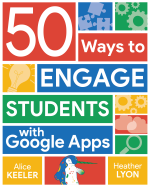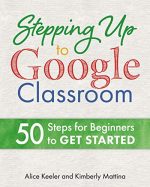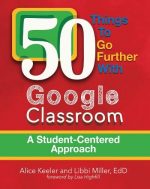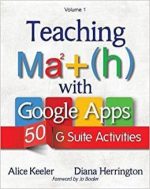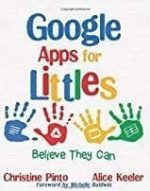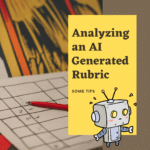Just when we all thought we could finally get back to what we know, generative AI, with tools like ChatGPT and Google Bard, came along and flipped the English teaching world upside down. It’s clear that trying to keep students away from these shiny new AI resources would be like trying to stop a tidal wave with a beach towel. So, instead of trying to play a never-ending game of whack-a-mole with technology, it’s time for us, the community of English Language Arts teachers around the globe, to roll with the punches. We have to find new ways to teach English that fit into this exciting and ever-changing landscape.

Creating an Image for This Post with AI
Using ChatGPT 4 I attempted to “Create a picture of an english teacher on a beach at the ocean with a giant wave with an armful of papers to grade in one hand and in the other a beach towl in the other trying to fight back the ocean wave.”
To communicate with words what you want visually is a challenge and took me several arguments with ChatGPT to end up with something I could accept. Below are some of the other results.




AI in Everything
In a very short period of time generative AI is being built into everyday common tools such as Microsoft Edge, Microsoft Word, Google Docs, Google Search, Canva Docs, and well… everything.
Using generative AI suddenly became everyone’s norm.
Educating students without addressing the existence and influence of generative AI falls short of fully preparing them for the realities they’ll face in today’s technologically advanced world. Such an approach would leave students unequipped to navigate and utilize these tools effectively, ethically, and responsibly. With AI now permeating various aspects of life, including education, work, and social interaction, it’s crucial that students understand its applications, strengths, limitations, and potential pitfalls. This includes learning how to critically evaluate AI-generated content, discern credible information from AI-driven misinformation, and comprehend the implications of AI in terms of privacy, bias, and ethics. Ultimately, acknowledging and integrating generative AI into English Language Arts teaching doesn’t just mirror the world students live in – it actively readies them for a future where AI will undoubtedly play an even larger role.
Some Shifts for the ELA Classroom
As we navigate the evolving landscape of education, particularly within English Language Arts (ELA) classrooms, it’s crucial to anticipate and adapt to the integration of generative AI technologies. These advancements are not so much replacing traditional tasks as they are enhancing our capabilities, allowing us to augment our skillsets in novel and empowering ways. In a future where the ability to leverage AI responsibly becomes a standard expectation in the workplace, the role of ELA education takes on new dimensions. It opens doors for students of all proficiencies, enabling those who might have struggled with traditional English tasks to excel in composing professional communications with AI assistance. This shift prompts us to reflect on the core competencies that ELA should foster. Critical thinking, creativity, ethical considerations, and a deep understanding of the nuances of human communication remain paramount. How, then, can we best prepare our students to harness the power of AI, not just as a tool for efficiency, but as a partner in cultivating these essential skills?
Process Over Product
The advent of generative AI calls for a fundamental rethinking of how we assess student learning in English Language Arts. Traditional assignment models, which often focus on the final written product, are becoming less effective in an era where students can easily generate polished written work with tools like ChatGPT. This doesn’t mean that writing assignments are no longer useful, but it does mean that the focus must shift from the product to the process.
Understanding and assessing the process of learning becomes paramount in this new landscape. The AI English teacher needs to place a greater emphasis on students’ research, brainstorming, drafting, revising, and reflection skills and documenting each stage along the way. For example, incorporating stages of brainstorming and outlining into the grading rubric in a more meaningful way can encourage students to engage more deeply with the planning and development phase of their work. Asking students to provide drafts, revisions, and reflective pieces about their writing process should never seem superflous, it should be fundamental, meaningful and enlightening.
The classroom can become a space for teaching students how to use AI as a tool to augment their learning rather than replace their intellectual work. For instance, students can be guided on how to use AI to generate ideas, provide writing prompts, or simplify complex texts. Then students can be asked to critically engage with these outputs, add their unique perspectives, and mold them into coherent arguments or narratives.
Communication Skills
Communication skills, particularly in writing, are highly valued across a broad range of professions. Today, generative AI tools like ChatGPT have the capability to assist anyone in creating professionally structured emails or documents. However, the ability to generate text doesn’t replace the essential skill of being able to craft, refine, and communicate our unique ideas clearly and convincingly.
The advent of AI brings a shift in focus for ELA teaching. It’s not enough for students to produce text; they must understand how to articulate their thoughts and how to critique and modify AI-generated content to accurately represent their understanding. Developing this aptitude requires teaching students how to analyze prompts, conceptualize their response, and then critically review the AI output to ensure it aligns with their intended message.
Effective communication, the art of argumentation, and the ability to convey thoughts concisely are not innate skills but ones learned and honed over time. In the classroom, students gain these proficiencies through reading, writing, and discussions which enable them to craft compelling arguments and express their ideas persuasively. With the integration of AI into the process, the role of the ELA teacher evolves to guide students in leveraging these tools ethically and effectively while fostering their human capacity for communication.
Digital Media and Video
Effective communication extends far beyond just the written word. In our increasingly digital world, visual and multimedia communication is becoming increasingly important. Consider the task of creating an impactful presentation, which often involves the use of engaging visuals instead of overwhelming text slides. Similarly, video content creation has also become a powerful medium for communicating ideas across an ever increasing variety of platforms.
Platforms like TikTok, with its 3-minute limit, challenge users to concisely engage an audience using visuals and media, teaching them a skill that’s in high demand today. Assignments that encourage students to communicate their thoughts and knowledge through videos and digital media not only increase their engagement but also build valuable 21st-century skills. This approach also combats the risk of AI-generated plagiarism, pushing students to work creatively and actively. By adapting to these new methods, we’re equipping our students with tools for success, not just for now but for the dynamic future ahead of them.
Classroom Discussions
Mastering verbal communication is also crucial. In everyday life, we can’t always rely on email and AI assistance to ensure our tone and message are received as intended. Implementing practices like classroom dialogue, Socratic seminars, and one-on-one conversations in our teaching not only equips students with the skills to communicate effectively in diverse situations but also fosters a more interactive and engaging classroom environment. These strategies give students firsthand experience in expressing their thoughts, responding thoughtfully to others, and navigating the complexities of conversation – essential skills that will benefit them in countless real-world scenarios. By nurturing these abilities, we’re preparing our students to effectively interact in personal, academic, and professional settings throughout their lives.
The AI English Teacher

Is AI Essays the End of Education?
ChatGPT can write essays for students using AI better than before. Is the sky falling? Is this the end of education? Is AI Essays the End of Education

Your AI Rubric Stinks
It is time consuming to create rubrics, especially good ones. Using AI can help, but what if your AI rubric stinks?

What Is Wrong with This AI Lesson Plan?
What is wrong with this AI lesson plan? I tried a popular lesson plan service and was greatly disappointed.

10 Ways Teachers Will Need to Adjust to Google Gemini
Google Bard, similar to ChatGPT, will play a role in changing the ways we approach teaching and learning. I asked Google Bard for how it thinks it will impact teaching. Here is what Bard said about 10 Ways Teachers Will Need to Adjust to Google Bard





